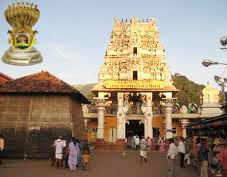Name of the Temple |
|
Location |
- This is situated in the banks of the river 'Dhāra' which originates in the Kumāra mountain in Sullia Taluk in South Karṇātaka , South India
|
| How to reach there? |
- By Air: The nearest airport is the Mangaḷūru International Airport, at a distance of 115 km. From there take the State Highway 113 south-east to reach Kukke.
- By Train : The nearest railway station is Nettana railway station 12 km from Kukke Subrahmaṇya. From the railway station take the State Highway 113 south.
- By Road: Kukke Subrahmaṇya can be reached by the National Highway 75 from Mangaḷūru and Bengalūru, also through the State Highways 100 from Mukrumpaḍi to Subrahmaṇya, 113 from Guruvayankere to Subrahmaṇya and 114 from Guḍya to Subrahmaṇya.
|
Rulers/builders and Time Period |
- Kukke Subrahmaṇya is on the bank of river Dhāra. According to Hindu Mythology Lord Kumāraswāmi came to this place after killing the demon rulers Thāraka, Sūrapadhmāsura and others in a war; and the Lord washed his Śhakthi Āyudha (a battle-axe of the type of a bayonet) in this river. From this onwards the river is famous as Kumāradhāra. After battle with the demon, Lord Kumāraswāmi came to the top of Kumāraparvatha along with his brothers Lord Ganeśha, Vīrabāhu and other aids.
- He was received by Lord Indhra along with other Gods; pleased by the success of the war Indhra prayed the Lord to be Kind enough to marry his daughter Dhevasena. This was agreed upon courteously and the marriage took place on the banks of on ‘Margashira Shuddha Ṣhaṣhṭi’ (The ṣhaṣhṭi is on the first half of Mārgaśhira Māsa.) Kumāradhāra Lord Kumāraswāmi also gave a darśhan to Vāsuki, the head of the Nāgas, who was making a penance here. Vāsuki prayed the Lord to stay along with him permanently in the place and the Lord blessed Vāsuki with the boon.
- The great Śhiva Bhaktha and Serpent king Vāsuki was performing thapas for years in the Biladhwāra caves of Kukke Subrahmaṇya to avoid the attack of Garuḍa. Following Lord Śhiva’s assurance Ṣhaṇmuka gave darśhan to Vāsuki and blessed him that he would stay with his parama bhaktha in this place forever.
- Hence the pūjās offered to Vāsuki or Nāgarāja are nothing but the pūjās to Lord Subrahmaṇya.
|
Deity/Deities |
- Lord Subrahmaṇya is the main deity of Kukke Subrahmaṇya Temple . Subrahmaṇya used to be called as Kukke Paṭṭaṇa in the past.
|
Architecture Style |
- Between the sanctorum and the portico entrance, there is the Garuḍa pillar covered with silver. It is believed that this pillar was charmed and planted there to shield devotees from the poisonous flames streaming from the breath of Vāsuki who resides inside.
- Beyond the pillar is the outer hall, the inner hall, and then the sanctorum of Lord Subrahmaṇya. At the center of sanctorum is a pedestal.
- On the upper dais stands the deity of Subrahmaṇya and the deity of Vāsuki and, at a somewhat lower level, the deity of Śheṣha . Ritual worship is offered to these deities every day.
|
Other Special Features |
- Sarpa Samskāra / Sarpa Doṣha is one of the pūjās performed by devotees at this temple to get rid of the sarpa doṣha (According to belief, a person, either in this birth or in any of his previous births, could be afflicted by the sarpa (serpent’s) doṣha (curse). Due to the widespread belief in the snake god in Tuḷunāḍu region of Karṇātaka and Keraḷa, this pūjā is performed by people of all faiths.
|
Special References |
- In the 'Śhankara Vijaya' Ānandhagiri observes that Śhrī Śhankarāchārya camped here for a few days during his religious expedition (Dhigvijaya).
- Śhankarāchārya referred to this place as 'Bhaje Kukke Lingam' in his 'Subrahmaṇya Bhujaṅgaprayatha Sthothram'.
- Śhrī Subrahmaṇya kṣhethra has been brilliantly described in the 'Thīrthakṣhethra Mahimaṇipurāṇa' chapter of the Sahyādhrikāṇḍa comprised in the Sanatkumāra Samhithā of Skandha Purāṇa.
|
Bibliography |
|















